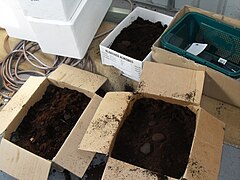Used coffee grounds
 Used coffee grounds in boxes. | |
| Usage |
|
|---|---|
Used coffee grounds is the result of brewing coffee, and are the final product after
In the late 19th century, used coffee grounds were used to adulterate pure coffee.[1]
Chemical composition
Most used coffee grounds are similar in chemical composition, although coffee grounds used to make instant coffee have fewer chemicals in them due to a more extensive extraction process.[2] Used coffee grounds are rich in sugars,[3] which comprise about half of their weight. A further 20% is made up of proteins, and a further 20% is lignins.[4] The dry coffee grounds contain significant amounts of potassium (11.7 g/kg), nitrogen (27.9 g/kg), magnesium (1.9 g/kg), and phosphorus (1.8 g/kg).[5] The quantity of caffeine remaining in used coffee grounds is around 48% of that in fresh coffee grounds.[6] There are significantly less tannins in used coffee grounds than fresh coffee grounds.[7]
Production
On average, 1 tonne of
Usage
Precautions
It is not recommended to burn dried used coffee grounds, as they give off hazardous
In gardens
In gardens, coffee grounds may be used for
In fortune telling
In divination and fortune-telling, the patterns of coffee grounds are used for predictions.
In the home
Dried used coffee grounds were recommended to fill
Agricultural uses

Initiatives have succeeded using coffee grounds as a substrate for the cultivation of mushrooms (including oyster mushrooms).[23][24] The use of spent coffee grounds in this application has the advantage of the used coffee grounds needing no pre-treatment to be usable as a mushroom substrate.[6]
Application of 10 kg used coffee grounds per square metre has been suggested as part of a
It has been proposed to use spent coffee grounds to feed ruminants, pigs, chickens and rabbits, but the high lignin content makes this an undesirable use.[26]
Industrial uses
Coffee grounds may be used industrially in
Biodiesel may be produced from coffee grounds, either directly by extracting the oils using solvents,[27] by mixing the grounds with methane and a catalyst,[28] or by using the grounds to feed bio-producing algae.[29]
In concrete making, 10-15% of the sand used may be replaced with used coffee grounds.[30]
It has been suggested to recover caffeine from used coffee grounds for commercial applications in
In 2021, Gloucestershire-based football club Forest Green Rovers trialed a kit made from 35% used coffee grounds combined with recycled plastic.
See also
References
- ISBN 978-0-465-02404-9
- ISSN 2073-4395.
- hdl:1822/16744.
- ^ S2CID 104298839.
- S2CID 38776511.
- ^ .
- PMID 30263620.
- .
- S2CID 135449537.
- S2CID 248138300.
- ^ a b c "Don't Throw Out Your Leftover Coffee Grounds!". Huffington Post. 4 August 2014. Retrieved 25 December 2014.
- ISBN 978-0-87857-991-4. Retrieved 5 January 2010.
- ^ a b "Coffee Grounds Perk up Compost Pile With Nitrogen". Life at OSU. 10 June 2009. Retrieved 1 April 2018.
- PMID 21704514.
- S2CID 44081836.
- ^ Southern Cultivator. J.W. & W.S. Jones. 1853.
- ^ "NORTH COAST GARDENING: Winter vegetable growing". Eureka Times-Standard. 24 December 2014. Retrieved 25 December 2014.
- ^ a b Chalker-Scott, Linda (2009). "Coffee grounds— will they perk up plants?" (PDF). Master Gardener. Puyallup Research and Extension Center, Washington State University. Retrieved 25 December 2014.
- ^ "Coffee for Your Plants? Starbucks Offers Free Coffee Grounds for Gardeners". Starbucks.com. Retrieved 13 December 2015.
- ^ "About Us | Coffee Grounds to Ground". Groundtoground.org. 24 May 2010. Retrieved 26 October 2011.
- ^ "Green Coffee Shop Scheme". Cambridge Food Hub. 8 May 2019. Retrieved 25 October 2019.
- ^ The Universal Household Assistant: A Cyclopedia of what Everyone Should Know... A.L. Burt. 1884. p. 347.
- ^ Dillen, Nina (18 June 2015). "Zelf oesterzwammen kweken op basis van ... koffiegruis? Zo doe je dat". Het Laatste Nieuws. Archived from the original on 21 April 2021. Retrieved 7 November 2023.
- ^ "PermaFungi |". 28 March 2014.
- S2CID 84273209.
- S2CID 27800545.
- ISSN 0021-8561.
- ^ Patel, Prachi (18 May 2017). "A simpler route to biodiesel from used coffee grounds". Anthropocene. Retrieved 9 October 2023.
- ^ Coxworth, Ben (2 November 2022). "Coffee grounds used to both feed and support biodiesel-producing algae". New Atlas. Retrieved 9 October 2023.
- ^ Christie, Damian (31 October 2019). "From coffee to concrete: Researchers offer a new solution". Quarry.
- .
